How to fix a display console that is difficult to read on Ambient Weather Station?
- JJohn RogersSep 9, 2025
Adjust the display contrast level. Also, try replacing the batteries in the console with a fresh set.
How to fix a display console that is difficult to read on Ambient Weather Station?
Adjust the display contrast level. Also, try replacing the batteries in the console with a fresh set.
What to do if Ambient Weather Station remote is not reporting to console?
The maximum communication range is 300 feet in line of sight. Try moving the sensor closer to the console, or if it's too close (less than 10 feet), move it further away. You can also try cycling power on the console, installing fresh batteries (lithium for cold weather), ensuring the sensor isn't transmitting through metal or earth, moving the console away from electronic devices, and raising the sensor's location. Radio Frequency Sensors cannot transmit through metal barriers or multiple, thick walls.
What to do if my Ambient Weather Station rain gauge reports rain when it is not raining?
If your rain gauge reports rain when it's not raining, it might be due to an unstable mounting. Ensure you have a stable mounting solution. Try moving the rain gauge from the pole mount to a flat, stable surface.
Why does the Ambient Weather Station temperature sensor read too high during the daytime?
In hot weather, the rain guard and solar shield might not be effective enough. Consider using a radiation shield.
What to do if Ambient Weather Station rain gauge reports rain when it is not raining?
To prevent false rain reports on your Ambient Weather Station, ensure the rain gauge is mounted on a stable surface. If it's currently on a pole, move it to a flat, stable structure to avoid any sway that could incorrectly increment rainfall.
What to do if software does not recognize Ambient Weather Station?
Make sure the USB cable is properly connected and recognized by your computer. If it's not recognized, try using a different USB port. Avoid using USB hubs.
Why indoor and outdoor humidity of Ambient Weather Station do not agree?
Allow up to one hour for the sensors to stabilize because of signal filtering. The indoor and outdoor humidity sensors should agree within 10 %, given the sensor accuracy is ± 5 %.
How to fix Ambient Weather Station display console if it is difficult to read?
Adjust the display contrast level as described in Section 5.1. You can also try replacing the console batteries with a fresh set.
Why do the indoor and outdoor humidity readings on my Ambient Weather Station not agree?
Allow up to one hour for the sensors to stabilize due to signal filtering. The indoor and outdoor humidity sensors should agree within 10 %, given the sensor accuracy is ± 5 %.
Why is the forecast icon on my Ambient Weather Station not accurate?
The weather station console needs to run for several days to trend barometric pressure. The weather forecast is an estimation of weather changes in the next 24 to 48 hours and varies by location. It should not be relied upon as an accurate method to predict the weather.
| Display Type | LCD |
|---|---|
| Wind Direction | 16 directions |
| Update Rate | Every 16 seconds |
| Display Backlight | Yes |
| PC Connectivity | USB |
| Transmission Frequency | 433 MHz |
| Wireless Range | 300 feet |
| Outdoor Temperature Range | -40°F to 140°F (-40°C to 60°C) |
| Indoor Temperature Range | 32°F to 122°F |
| Humidity Range | 10% to 99% |
| Rainfall Range | 0 to 393 inches (0 to 9999 mm) |
| Power (Base Station) | AC adapter or 3 AA batteries |
| Power (Remote Sensors) | 2 x AA batteries |
| Data Storage | Yes |
| Weather Forecast | Yes |
| Alarms | Yes |
Lists all the included components and hardware for the weather station.
Lists essential tools required for the assembly and installation of the weather station.
Details the step-by-step process for assembling the wind speed and direction sensors.
Details the layout and components of the display console interface.
Instructions for setting up the display console and ensuring sensor communication.
Explains the process and timing for the console to synchronize with the Radio Controlled Clock signal.
Steps to verify the correct operation of all sensors before final installation.
Recommends operating the station temporarily to check functions and wireless range.
Provides factors to consider when selecting a suitable location for the sensor array.
Details the final mounting and alignment of the sensor array components.
Instructions for setting the time, time zone, and daylight saving time on the console.
Steps to set the date, date format, and alarm settings on the console.
Configuration options for wind speed units, high alarms, and direction alarms.
Settings for rain increment display, units, high alarm, and resetting rain data.
Details on displaying pressure, units, and calibration for absolute and relative pressure.
Information on viewing and configuring the pressure history graph display.
Explains how the weather forecast tendency is derived from pressure changes.
Configuration for indoor temperature units, high/low alarms, and record high/low values.
Settings for indoor humidity high/low alarms and record high/low values.
Configuration for outdoor temperature units, alarms, and record values for temp, wind chill, dew point.
Settings for outdoor humidity high/low alarms and record high/low values.
Details on how the console stores data, memory capacity, and how to clear memory.
Guides on calibrating sensors for temperature, humidity, and wind speed for accuracy.
Calibrating wind speed using a multiplier against a known source for accuracy.
Adjusting indoor temperature readings to match a calibrated thermometer.
Adjusting indoor humidity readings using calibration kits for accuracy.
Adjusting outdoor temperature readings to match a calibrated thermometer.
Adjusting outdoor humidity readings for better accuracy.
Overview of EasyWeather software capabilities for data display, programming, and analysis.
Steps for connecting the weather station console to a PC via USB cable.
Instructions for installing the EasyWeather software from the provided CD.
Guidance on launching the EasyWeather software and running as administrator if needed.
Describes the main display window of EasyWeather showing current conditions and data.
How to program console settings and manage alarm conditions using the software.
Setting specific alarm ranges for various weather parameters within the software.
Viewing historical maximum and minimum recorded weather data.
Accessing, viewing, and exporting recorded historical weather data in a spreadsheet format.
Viewing graphical representations of historical weather data.
Procedure to clear accumulated rainfall data within the EasyWeather software.
Details on transmission range, update rate, and frequency for wireless communication.
Specifications for accuracy and resolution of various measured weather parameters.
Information on the power requirements and battery types for the base station and remote sensor.
Specifies the lengths of cables connecting different sensor components.
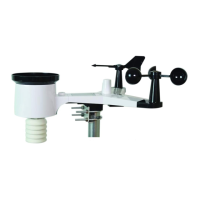
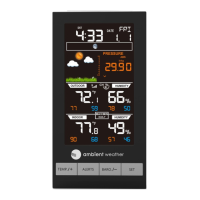
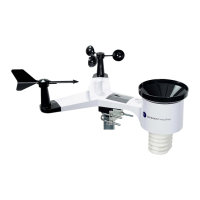
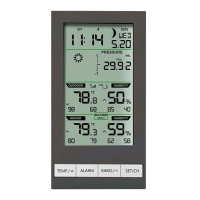
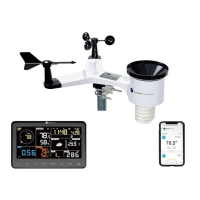
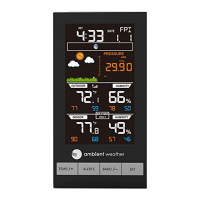
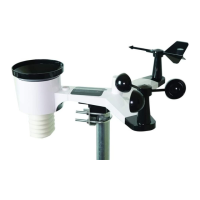
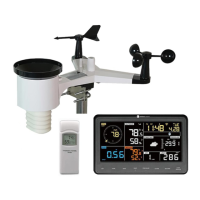
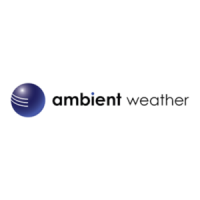


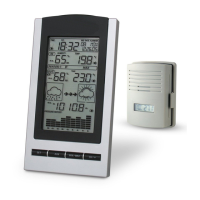
